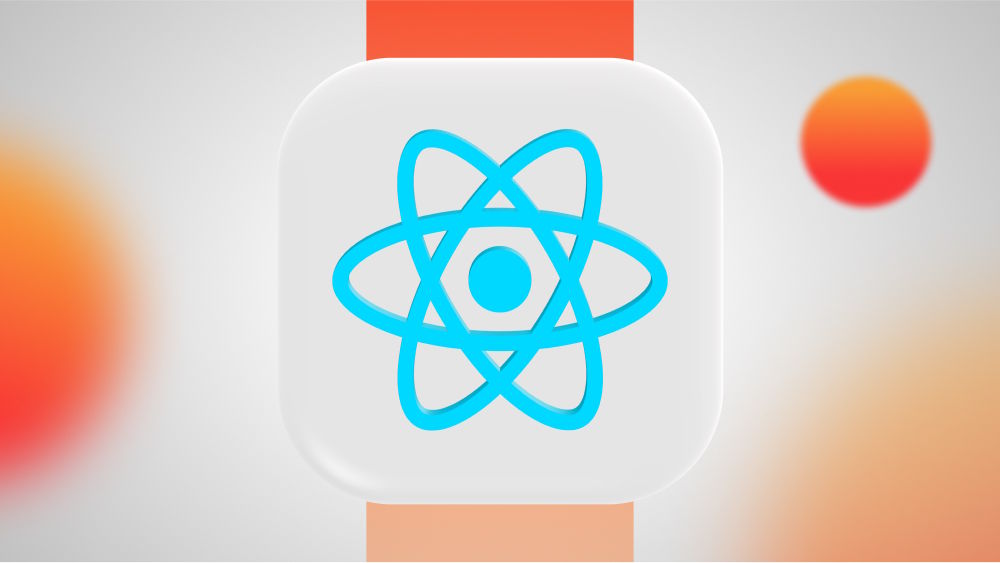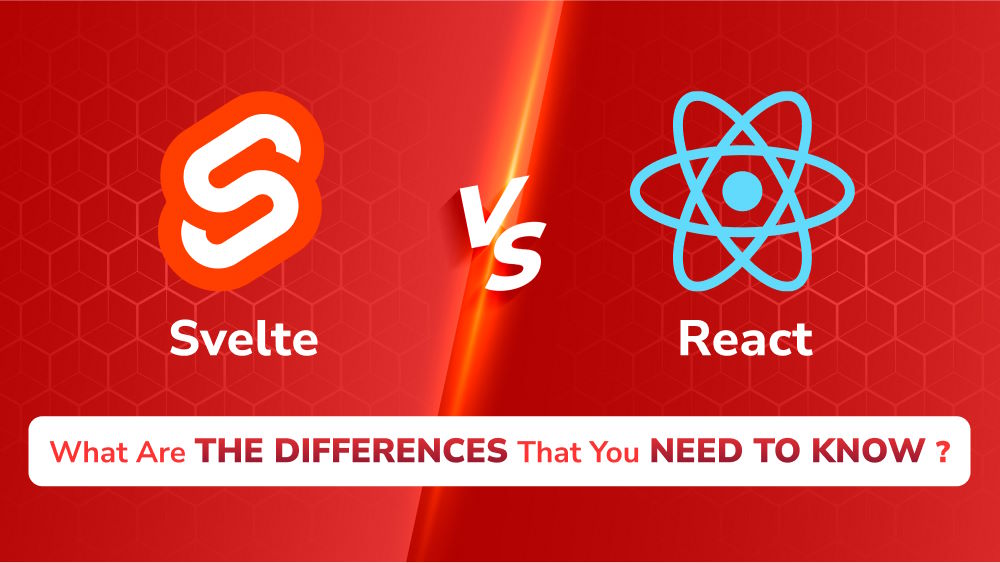
React Native vs. React: Finding Your Sweet Spot for Harmonizing These Two Technologies
Even past the either/or discussion, this article will walk you through the unique advantages of React & React Native. Discover the most important decision factors and useful strategies (Web First, Mobile Later, Parallel Dev, Monorepos), and learn how these useful technologies can be reconciled to enable the best of both worlds: web and mobile development.
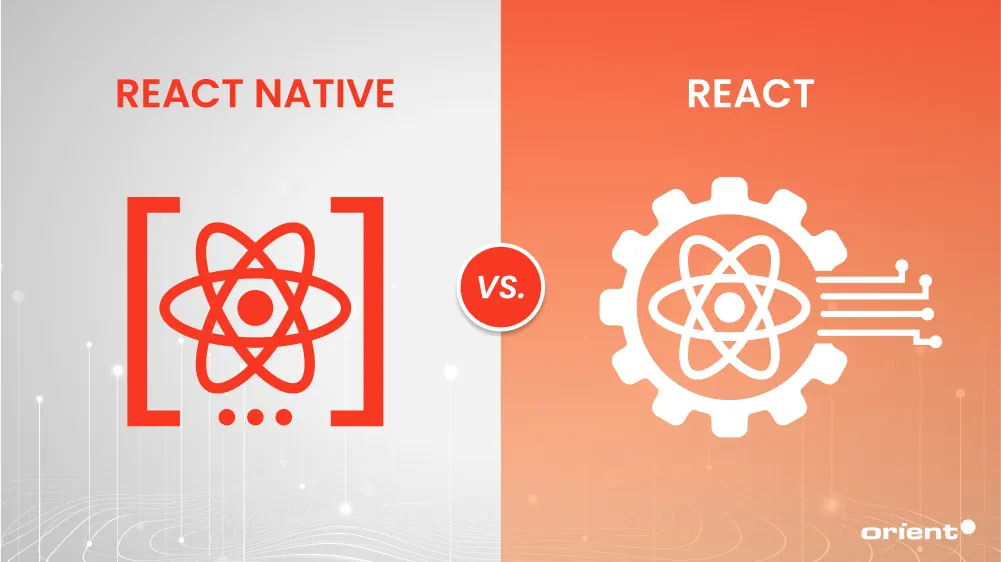
Content Map
More chaptersAs of 2025, React Native has seen a massive adoption boost, and 88% of software developers believe it is following the right path. Additionally, Expo is the framework that simplifies React Native development, making the process of starting and deploying apps in React Native even more streamlined. At the same time, React is still the leading web development tool, and its ecosystem includes React Server Components to enhance performance and reduce the amount of data transferred.
Yet this very success has had a side effect: the interchangeable, albeit distinct, terms “React” and “React Native.” For many, these names habitually become conflated, creating confusion about their essential function, utility, and best circumstances for use.
This confusion is totally understandable, but let’s clarify it simply. When someone says, “I’m a React developer,” it typically implies specialization in building web applications that run in the context of a browser. But when they say, “I’m a React Native developer,” they mean specialization in building mobile applications that run natively on iOS and Android operating systems. The distinction, though subtle in words, is critical in practice.
Conventional wisdom presents “React Native vs. React” as an either/or dilemma, as though a single correct answer exists for all. This article will make the case against this narrow thinking and suggest a more tactical alternative: harmonizing these two powerful technologies. Understanding their relative strengths and weaknesses and how and when they might be made to work together is the key to realizing maximum efficiency, scalability, and user experience. By going beyond the “vs.” mentality and embracing the “how to integrate” mentality, you can take advantage of the full potential of React and React Native for building strong, high-performance, and future-proof apps for both web and mobile platforms.
React (React.js)
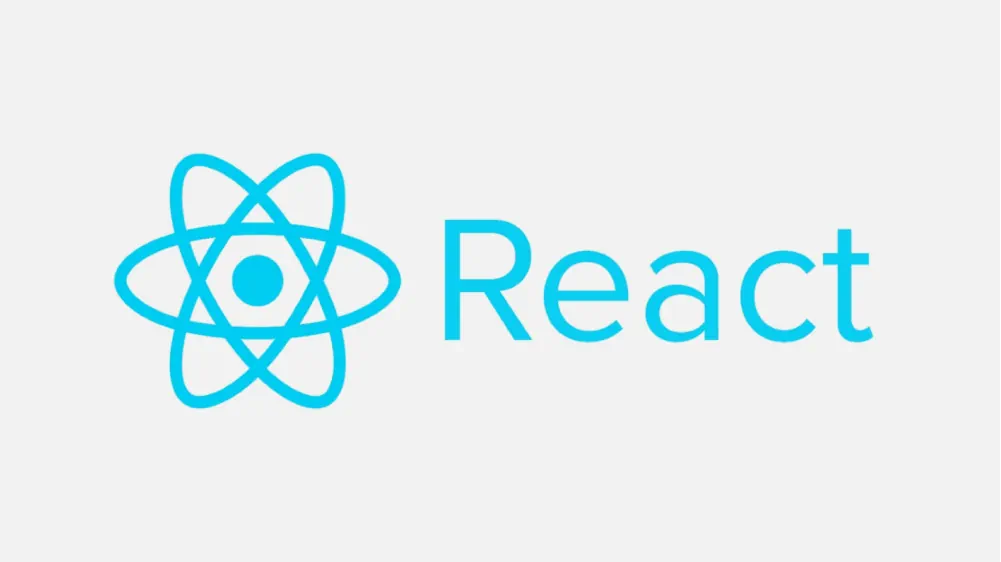
React.js, a JavaScript library, specializes in creating user interfaces (UIs) for web applications. Created by Facebook (since renamed Meta) and published as an open-source initiative, React simplifies the creation of interactive, dynamic web apps and is based on a component-based design. A remarkable difference with the traditional approach is that, instead of directly operating on the Document Object Model (DOM), React.js renders a Virtual DOM, which provides significant optimization in rendering efficiency and updates complex user interfaces more quickly and smoothly.
Key Characteristics of React (React.js):
- Platform
React is used in web browsers and is compatible with HTML, CSS, and JavaScript. Being a front-end library, it allows developers to create modular and reusable UI elements (user interfaces) that may interact with the JavaScript DOM. - Output
React does not operate directly on the DOM of the browser. Rather, it first renders components to a virtual DOM, an intermediate representation. State or prop changes cause an efficient update algorithm that first compares the differences (through the React reconciliation process) and then applies the minimal changes to the real DOM in the browser. This will boost performance because it will limit unwanted re-renders. - Components
The basic components of React are similar to HTML elements but are defined using a syntax named JSX (JavaScript XML). JSX is a format that lets developers use an HTML-like syntax to represent UI elements but incorporate JavaScript logic. Components may be written as class-based or functional, and hooks provide a way to keep state and lifecycle effects in function-based components. - Ecosystem
React is, among other things, a standalone library, but it exists within a large ecosystem of web development. It works perfectly with frameworks such as Next.js and Gatsby that support server-side rendering (SSR) and static site generation (SSG). Create React App (CRA) enables easier configuration of a new React project, whereas Redux and other state management libraries assist in keeping the application-wide data consistent. There are also millions of UI libraries, including Material-UI, Chakra UI, and Ant Design, available to developers. - Typical Use Cases
React React is popular in making single-page applications (SPAs), where the UI can be updated dynamically without reloading the whole page. Also, it is frequently used in Progressive Web Apps (PWAs), which provide app-like experiences inside web browsers. It is most often employed in sophisticated dashboards, e-commerce applications, interactive websites, and real-time data visualization interfaces, and thus has become a default solution to present-day front-end development.
React continues to get better with new features such as concurrent rendering, React Server Components, and better developer tooling, making it one of the strongest and most popular libraries used in web development.
React Native
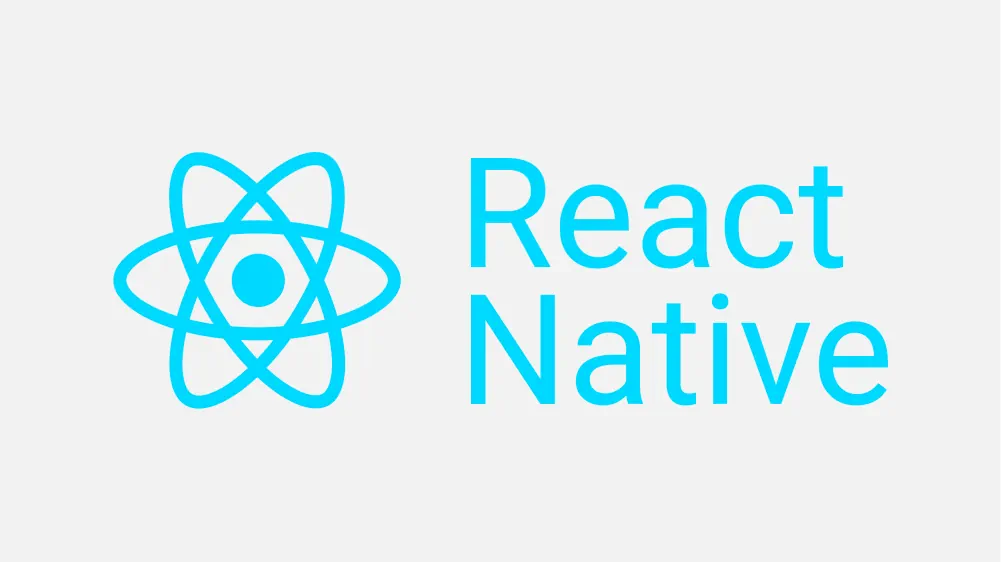
React Native is a JavaScript framework that allows the development of fully native mobile apps with React principles. It does not simply wrap web views, like early incorrect assumptions, but directly binds to native UI elements, which enables developers to develop iOS and Android apps using a shared codebase. React Native was also created by Facebook (now Meta) to simplify mobile development but keep the same declarative, component-based design of React.
Its popularity among developers as a top cross-platform mobile development solution has been solidified even further with recent ecosystem updates, including Expo SDK 50, the integration of the Fabric renderer as the default, and React Native for Web entering production-ready status. React Native has since been used in more than just startups, with key applications used by such companies as Instagram, Airbnb, and Shopify.
Key Characteristics of React Native:
- Platform
React Native runs on iOS and Android, and with it, developers can create JavaScript code that is compiled into native app experiences. The framework itself uses platform-specific APIs and optimizations but provides consistency between the two mobile operating systems. - Output
Instead of being based on web views like hybrid frameworks, React Native compiles components to native UI elements. To take a specific example, an<Image><View>in React Native maps to a UIView on iOS and an android.view component on Android. This direct native translation provides optimum performance and a flawless user experience. - Components
React Native provides a collection of native components that are comparable to HTML elements but fit the mobile platforms. Important elements are<Text>to show text,<Image>to draw images, and<Button>to manage user events. Functionality can also be expanded upon with custom native modules developed in either Swift, Objective-C, Kotlin, or Java by developers. - Ecosystem
The ecosystem of React Native is mobile-oriented, which means that it includes well-known libraries like Expo to simplify development processes, React Navigation to handle routing, or NativeBase to provide UI components. Moreover, built-in modules or third-party packages in React Native give developers access to platform-specific features like camera access, GPS location, and push notifications. - Typical Use Cases
React Native is widely used for cross-platform mobile applications, where both iOS and Android apps can be developed simultaneously by companies. It is an ideal choice for startups’ MVPs, where rapid prototyping can be attained with fewer development costs. React Native is also very suitable for apps that require device-specific features, such as apps with GPS, cameras, and real-time push notifications.
Head-to-Head Comparison: React vs. React Native
To offer a rich parallel comparison, the following table systematically outlines the core distinctions and similarities between React and React Native.
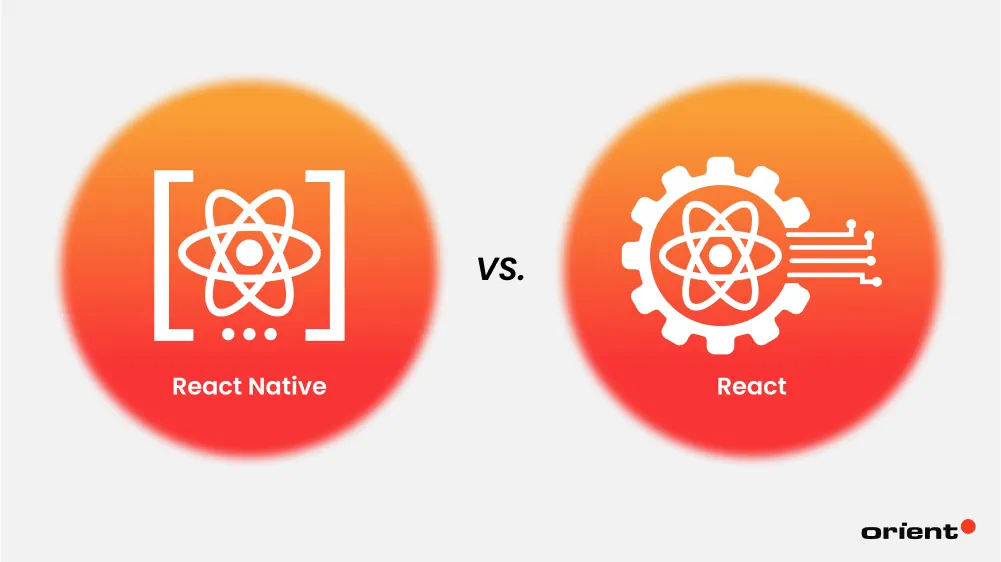
Key Differences Table between React Native vs. React
A clear comparison table is excellent for highlighting the contrasts between React and React Native.
| Feature | React (React.js) | React Native |
|---|---|---|
| Purpose | Builds user interfaces for web applications | Develops fully native mobile apps for iOS & Android |
| Platform | Web browsers (HTML, CSS, JavaScript) | Mobile operating systems (iOS & Android) |
| Rendering | Uses Virtual DOM, then updates the browser’s DOM | Converts components into native UI elements (UIView for iOS, android.view for Android) |
| Component Types | JSX-based elements (e.g., <div>, <span>) | Native mobile components (e.g., <View>, <Text>, <Button>) |
| Navigation | React Router for web navigation | React Navigation or native navigation solutions for mobile |
| Styling | Uses CSS, styled-components, and external UI libraries | Uses StyleSheet API (similar to CSS), or third-party libraries like NativeBase |
| Ecosystem | Vast web development ecosystem (Next.js, Gatsby, CRA) | Mobile-focused tools (Expo, React Navigation, access to native modules) |
| Use Cases | SPAs, PWAs, interactive websites, dashboards, e-commerce platforms | Cross-platform mobile app development, MVPs, apps requiring device-specific features (camera, GPS, notifications) |
Shared DNA: What Makes React Native and React Similar?
While their outputs and platforms differ significantly, React and React Native share a foundational DNA that makes them intimately related.
| Feature | React (React.js) & React Native |
|---|---|
| Core Library | Both are built on React, utilizing its component-based architecture and declarative UI principles. |
| JSX Syntax | Both use JSX (JavaScript XML), allowing developers to write UI components in an HTML-like structure within JavaScript. |
| Component-Based | Both encourage reusable, modular components, making code maintenance and scalability easier. |
| State & Props | Both rely on state and props to manage dynamic UI updates and data flow between components. |
| Lifecycle Methods & Hooks | Both support React’s lifecycle methods and hooks (useState, useEffect, etc.) for functional components. |
| Virtual DOM-like Efficiency | React uses a Virtual DOM for web, while React Native utilizes a similar reconciliation process for native rendering optimizations. |
| Third-Party Libraries | Both benefit from an extensive ecosystem of third-party libraries for UI components, navigation, and state management. |
| Cross-Platform Flexibility | React runs on the web, while React Native extends React’s flexibility to mobile, enabling JavaScript-based cross-platform development. |
Strategies for Harmonizing React and React Native: Practical Approaches
Successfully integrating React and React Native into a cohesive development strategy isn’t about choosing one over the other but rather about leveraging their respective strengths. The following are some of the pragmatic ways of balancing these technologies with their respective benefits and reflections.
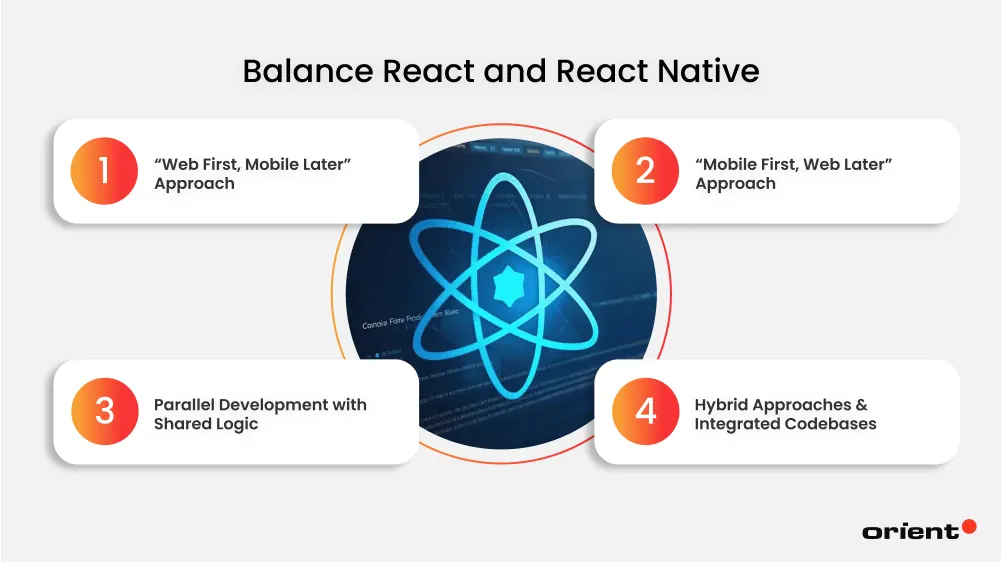
“Web First, Mobile Later” Approach
When using this approach, one would normally develop a powerful React web application first and then optimize it in terms of its architecture, state management, and reusable UI components. After the web version has stabilized and is successful, then the relevant business logic, API integrations, and possibly even parts of the core UI components are then ported or adapted to React Native.
As an example, consider a React web application with a complicated data fetching and rendering component: the Redux reducers, sagas, or React Query hooks of the corresponding component can be frequently directly usable in a React Native project. Likewise, common utility functions to format, validate, or authenticate data can be included in the React Native project.
The benefits of such an approach are considerable. It enables testing the idea and gaining market validation, possibly with reduced initial cost, as web development usually has a wider talent base and quicker initial deployment. You have access to the enormously large and developed web ecosystem of React.js, with strong frameworks such as Next.js server-side rendering and search engine optimization, INFINITE UI libraries, and advanced debugging tools. This has the ability to speed up the initial development cycle and to tighten the main product features with actual user feedback.
However, there are drawbacks; the first one is the possibility of major refactoring during the port to native. Business logic may be reusable, but UI components usually require a total rewrite in terms of native components of React Native. An <div> on-the-web will not simply convert to a <View> on mobile, and paradigms of styling are different. That requires a separate mobile UI development step, even when the same logic is used. Designers may also be required to translate web-first designs to mobile-native patterns, which in some cases becomes an afterthought unless considered upfront.
“Mobile First, Web Later” Approach
Conversely, the “Mobile First, Web Later” paradigm is centered around creating a native-feeling mobile app using React Native as a first step. This is particularly normal for startups or products where the first user interaction channel is going to be mobile.
In this case, it is about using React Native as a baseline to build core functionality, creating a powerful mobile experience, and leveraging device capabilities. Once having a good mobile presence, the plan is to expand this to the web, often with solutions such as React Native for Web. This library adds a compatibility layer on top of React Native, making it possible to render React Native components and APIs in a web browser, mapping native components (such as <View>, <Text>) to their HTML equivalents (<div>, <p>).
The pros of this strategy are that there is an early mobile presence, which is essential in mobile-heavy markets or where the app uses device-specific features. And then there is the promise of a unified codebase effort, with React Native for Web wanting to enable a large part of your UI code to be shared between mobile and web. This has the potential to result in decreased overhead of maintaining two completely separate frontends since much of the styling and component logic can be kept the same.
But this way also has its drawbacks. The web experience may be less native, or idiomatic, than a web application composed purely of React.js and web-specific frameworks. React Native for Web is capable, but it is a compatibility layer, and in some cases the translated web output may not use advanced web capabilities or complex browser APIs as seamlessly as a dedicated web app.
Moreover, the web ecosystem drawbacks may become evident; although the component set blogged with React Native will render on the web, the developers may lose access to highly optimized web-specific libraries, SEO capabilities baked into frameworks such as Next.js, or advanced CSS functionality that is a normal part of pure web development. Making sure that the web version does not feel like a compromised mobile port takes special attention.
Parallel Development with Shared Logic
The thinking behind this strategy is to build independent and distinct frontends between React (web) and React Native (mobile) while placing a heavy emphasis on code-sharing and infrastructure. The key here is to have two separate UI codebases that follow the respective conventions and user expectations on the respective platforms and keep as much similarity in the non-UI layers as possible.
This is usually implemented by sharing a common backend, which offers APIs to the web application and the mobile application. Other than the backend, a good part of the application business logic, data models, utility functions, and even state management logic can be shared. For example, reducers, actions, and selectors can be implemented once and imported into the React web app and the React Native mobile app when using a state management library such as Redux.
Equally, validation schemas (e.g., using Yup or Zod), data formatting utilities, authentication logic, and network request wrappers (e.g., using Axios or Fetch) can live in a shared library or package in the project structure, shared by both frontends. This provides a level of consistency across platforms in the data handling and any business rules that apply, with the user interface showing that the data controller is quite different.
The primary advantage of this strategy is the possibility to provide the best UX on every platform. Because the UI is tailor-made to run on web browsers and native mobile settings, respectively, developers have complete access to platform-specific capabilities, design patterns, and performance tuning.
Complex CSS animations, cutting-edge browser APIs, and high-performance SEO are available on the web app platform, whereas, on mobile, you can take advantage of realistic native gestures, device integrations (such as Face ID or haptic feedback), and platform-specific UI patterns (e.g., bottom tab navigation on iOS, drawer navigation on Android). It also results in a clean separation of concerns, with each frontend codebase being simpler to manage, debug, and optimize in its target environment without affecting the other adversely.
However, this method has the disadvantage of increased development and maintenance overhead. While shared logic, two distinct UI codebases mean that effort has to be duplicated in UI development, design, and testing. Every new feature in the UI or modification in the UI design has to be performed twice in the web and mobile domains, despite shared business logic. This can lead to an extended total development period and higher long-term maintenance cost than a single, truly integrated codebase, involving more programmers or more time for an equal set of features.
Hybrid Approaches & Integrated Codebases
Moving towards even greater harmonization, “Hybrid Approaches & Integrated Codebases” focus on architectural patterns and tools that enable significant code sharing and streamlined development across React and React Native within a unified project structure.
Monorepos
A monorepo consists of many different projects in a single repository, commonly sharing code packages. In the case of React and React Native, this implies the codebase of the web application and the codebase of the mobile application (as well as shared utilities, design systems, and backend code) are both located in the same Git repository. Monorepos are usually managed with tools such as Lerna or Nx, which offer dependency hoisting, running scripts across packages, and effective caching. This structure enables developers to simply import shared elements, utility functions, or state management logic in one package (e.g., packages/shared-ui or packages/business-logic) into another (e.g., apps/web-app or apps/mobile-app). The main advantage is better discoverability of code, dependency management, and atomic commits that apply to both platforms, making changes consistent with each other.
Component Libraries
A very effective code reuse strategy is the development of platform-independent UI component libraries. Though certain components will necessarily be platform-specific (e.g., a web-only <table> or a mobile-only camera component), many can be abstracted to compile on both. It entails developing components whereby their logic is well distinguished through their rendering. To give an example, a Button component could share logic around clicks, loading states, and accessibility props, but the actual visual rendering would be conditional. It may compile a plain HTML <button> element on the web and a React Native <Pressable> or <TouchableOpacity> on mobile, but with a similar API. This is made possible by libraries such as React Native for Web (discussed above), which can translate React Native primitives into web-compatible elements, meaning a large percentage of UI components can be written once and deployed to both.
Design Systems
It is essential to have a well-developed design system that will promote the same user experience and visual identity across various platforms, irrespective of the technology used. But this is not really about code; it is about common principles, guidelines, and reusable design assets. A design system offers a source of truth (single) about colors, typography, spacing, iconography, and component states. Although particular UI elements may be realized differently in React (CSS-in-JS, Tailwind) and React Native (JavaScript stylesheets), they follow the same visual prescriptions of the design system. Documentation and presentation of components can then be done using tools such as Storybook, enabling designers and developers to keep peace even when using different UI implementations on both platforms.
Shared Utilities/Reducers
As covered in the Parallel Development section, shared state management using libraries such as Redux or Zustand is a key concept of harmonization. The main part of the state logic (reducers, actions, slices) can be implemented once and used by both React and React Native apps. This makes the data layer of the application, along with its business logic and state changes, act the same way on any platform, although the UI may be different. In addition to state management, data manipulation, formatting, validation, network requests, and authentication are all functions that share utility in this category. These are commonly in their own, platform-agnostic packages in a monorepo or as standalone modules, so that important non-UI logic is always used in the same way everywhere.
Partner with Experts for Harmonizing ReactJS and React Native

It requires great technical vision and a highly developed sense of their respective strengths and weaknesses to successfully pick one’s way through the complexity of choosing between React and React Native or, more strategically, of balancing them against one another in your product stack. While the theoretical advantages of shared logic and less cluttered experiences are obvious, executing such an approach in practice needs hands-on experience, architectural planning, and proven history. It is here that working with world-class development partners becomes invaluable.
For businesses looking to bridge the divide between their web and mobile presence, with seamless user experiences and simplified development cycles, it’s imperative to work with a party that has experience working with React.js for web development and React Native for mobile application development. A solid partner can provide not just development capacity but also strategic guidance on selecting the right strategy—whether it is a “Web First, Mobile Later” launch, a “Mobile First, Web Later” expansion, or a sophisticated parallel development model with deep code sharing.
Orient Software is a prime example of this kind of partner, with extensive experience in both React and React Native for end-to-end mobile and web development solutions. With a proven success record in developing high-performance, scalable apps across a range of industries, Orient Software knows the intricate nuances involved in developing integrated digital experiences. Our teams are experts at implementing cutting-edge architecture patterns, like monorepos for effective codebase organization, developing and integrating platform-agnostic component libraries for maximum UI reuse, and building robust design systems that will deliver brand consistency throughout all touchpoints. To see how our expertise can drive your digital transformation, contact us right now!


